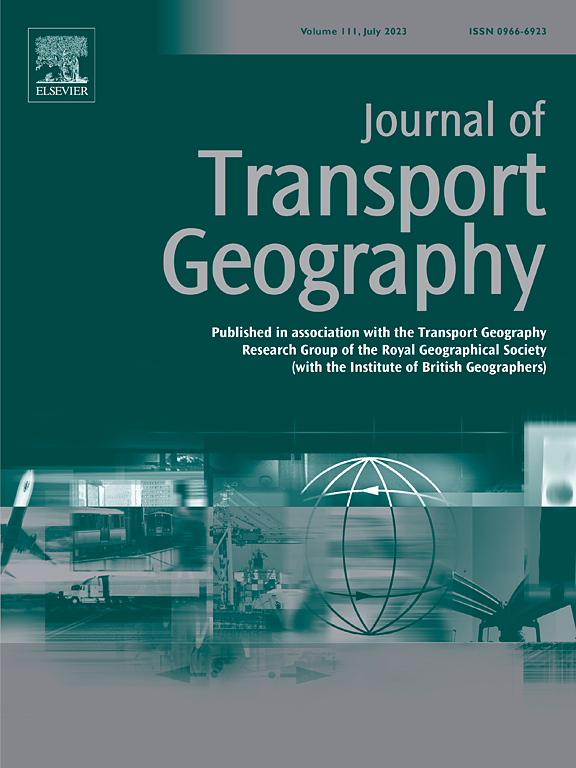Envisioning shared autonomous vehicles (SAVs) for 374 small and medium-sized urban areas in the United States: The roles of road network and travel demand
IF 5.7
2区 工程技术
Q1 ECONOMICS
引用次数: 0
Abstract
This study envisions a future of operating shared autonomous vehicles (SAVs) to provide mobility services in 374 small and medium-sized urban areas (population < 375,000) in the United States. Specifically, this study 1) generates large-scale synthetic commuting trip data for 374 urban areas, 2) employs an agent-based modeling framework to simulate the operations of SAV fleets serving commuters in these areas, and 3) develops models to explain the variations of fleet performances across study areas. The main objectives of this study are to compare the performances of SAVs serving commuting trips across urban areas and to identify the correlates of SAV fleet performances related to regional road networks and travel demand characteristics. This study generated 30 million synthetic commuting trips for 374 small and medium-sized urban areas based on the Census' latest Longitudinal Employer-Household Dynamics (LEHD) data and the National Household Travel Survey (NHTS) data. Based on the agent-based modeling results, SAV fleet performances across 374 urban areas were analyzed. Key performance measures include the average number of trips per SAV vehicle for fleet efficiency and the percentage of empty vehicle miles traveled (VMT) for extra operating costs. Results showed significant spatial variations in SAV fleet performances across 374 urban areas. The results highlighted urban areas that either outperform or underperform other areas. For example, Great Falls MT, is associated with the highest fleet efficiency, and Fort Walton Beach-Navarre-Wright, FL, has the lowest percentage of empty VMT. Through statistical modeling, this study identified significant correlates of SAV fleet performance, which are significantly related to factors of road network properties and travel demand characteristics. A larger, denser, and more connected network is associated with greater fleet efficiency and reduced operating cost, while a network with a local clustering tendency may lead to decreased fleet efficiency and increased operating cost. Areas with denser trips or longer trips are associated with lower fleet efficiency and decreased operating costs. More modeling results are discussed in the paper, providing insights into how different local road network characteristics and travel patterns influence the operation of SAVs. These results help to identify strategies for tailoring SAV services to the unique needs of different regions. This study complements the literature on shared mobility and automation research currently centered on great metropolitan areas. The research findings are intended to serve as the basis for future discussions regarding opportunities and challenges of deploying emerging mobility services in small and medium-sized areas. The large-scale synthetic commuting data generated in this study are valuable for researchers and agencies to develop advanced travel and mobility models and to further explore the potential of deploying emerging mobility systems in these areas.
展望美国374个中小型城市地区的共享自动驾驶汽车(sav):道路网络和出行需求的作用
这项研究设想了共享自动驾驶汽车(sav)在374个中小城市地区(人口和数量)提供移动服务的未来。37.5万)。具体而言,本研究1)生成了374个城市的大规模综合通勤行程数据,2)采用基于agent的建模框架模拟了这些地区为通勤者服务的SAV车队的运行情况,3)建立了模型来解释研究区域之间车队性能的变化。本研究的主要目的是比较服务于城市通勤的自动驾驶汽车的性能,并确定与区域道路网络和旅行需求特征相关的自动驾驶汽车车队性能的相关性。这项研究基于人口普查最新的纵向雇主-家庭动态(LEHD)数据和全国家庭旅行调查(NHTS)数据,为374个中小城市地区生成了3000万次综合通勤。基于智能体建模结果,分析了374个城市地区的自动驾驶汽车车队性能。关键绩效指标包括每辆SAV车辆的平均行程次数,以提高车队效率,以及额外运营成本的空车行驶里程(VMT)百分比。结果表明,在374个城市地区,SAV车队的表现存在显著的空间差异。结果显示,城市地区的表现要么优于其他地区,要么低于其他地区。例如,MT大瀑布的车队效率最高,佛罗里达州的Fort Walton Beach-Navarre-Wright的空车里程百分比最低。通过统计建模,本研究发现了自动驾驶汽车车队绩效的显著相关性,这些显著相关性与道路网络属性和出行需求特征因素相关。网络规模越大、密度越大、连接程度越高,车队效率越高,运营成本越低,而局部集群化的网络则可能导致车队效率降低,运营成本增加。在行程密集或行程较长的地区,车队效率较低,运营成本较低。本文讨论了更多的建模结果,为不同的局部路网特征和出行模式如何影响自动驾驶汽车的运行提供了见解。这些结果有助于确定针对不同区域的独特需求定制SAV服务的策略。本研究补充了目前以大城市为中心的共享交通和自动化研究文献。研究结果旨在作为未来关于在中小型地区部署新兴移动服务的机遇和挑战的讨论的基础。本研究中生成的大规模综合通勤数据对于研究人员和机构开发先进的出行和移动模型以及进一步探索在这些领域部署新兴移动系统的潜力具有重要价值。
本文章由计算机程序翻译,如有差异,请以英文原文为准。
求助全文
约1分钟内获得全文
求助全文
来源期刊

Journal of Transport Geography
Multiple-
CiteScore
11.50
自引率
11.50%
发文量
197
期刊介绍:
A major resurgence has occurred in transport geography in the wake of political and policy changes, huge transport infrastructure projects and responses to urban traffic congestion. The Journal of Transport Geography provides a central focus for developments in this rapidly expanding sub-discipline.
 求助内容:
求助内容: 应助结果提醒方式:
应助结果提醒方式:


